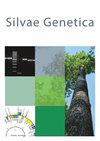乌卡亚利Aguaytia河流域三种环境下瓜祖马(Guazuma crinita)后代的生产力、适应性和稳定性测试Perú
IF 1
4区 农林科学
Q3 FORESTRY
引用次数: 0
摘要
Guazuma crinita是一种快速生长的树木,由于其木材产量快,可以为秘鲁亚马逊地区小农的生计做出重大贡献,因此具有在农林复合系统中使用的潜力。然而,高需求导致的滥伐正在导致天然林的消失。因此,国际农林业研究理事会(ICRAF)开始了一项驯化计划,以减少对该物种自然种群的压力。本研究的目的是利用遗传参数、适应性(PRVG)、生产力(MHPRVG)和稳定性(MHVG)分析,从秘鲁乌卡亚利Aguaytía河流域建立的3年后代试验中选择G. criinita基因型。试验建立在三个不同的地点,三个街区,每个街区200个子代,每个地块2个个体。测定的性状为胸径(DBH)、总高度(H)和总空中生物量(B)。子代间各性状差异显著,但不存在基因型x环境互作(GxE)。然而,位点之间的基因型相关性很重要(> 0.702),这表明通过跨位点选择相同的后代可以实现遗传改良。各性状的平均遗传力中等(0.34 ~ 0.369),联合位点分析的选择精度较高(0.583 ~ 0.608)。通过MHVG、PRVG和MHPRVG的组合分析选择DBH,在所有环境中鉴定出50个优良后代(25.9%)。这些应该在育种计划中优先考虑,因为它们可以为未来的选择周期提供稳定的遗传变异性。本文章由计算机程序翻译,如有差异,请以英文原文为准。
Productivity, adaptability, and stability in Guazuma crinita progeny tests across three environments in the Aguaytia River Basin, Ucayali, Perú
Abstract Guazuma crinita is a fast-growing tree with potential for use in agroforestry systems, due to its rapid wood production, which can contribute significantly to the livelihoods of small-scale farmers in the Peruvian Amazon. However, indiscriminate logging due to high demand is leading to the disappearance of natural forests. As such, the International Council for Research in Agroforestry (ICRAF) began a domestication program to reduce pressure on natural populations of the species. The objective of the present study was to use analyses of genetic parameters, adaptability (PRVG), productivity (MHPRVG), and stability (MHVG), to select G. crinita genotypes from a three-year-old progeny test established in the Aguaytía River Basin, in Ucayali, Peru. The test was established in three different sites, with three blocks, 200 progeny per block, and two individuals per plot. The measured traits were diameter at breast height (DBH), total height (H), and total aerial biomass (B). Significant differences in traits between progenies were detected, but with no genotype x environment interaction (GxE). However, the genotypic correlation among sites was important (> 0.702), suggesting that genetic improvement is possible by selecting the same progeny across sites. The mean heritability among progenies was moderate for all traits (0.34–0.369) and selective precision through combined site analysis was relatively high (0.583–0.608). Based on selection for DBH through combined analysis, MHVG, PRVG, and MHPRVG, 50 superior progenies (25.9 %) were identified for all environments. These should be prioritized in breeding programs as they can offer stable genetic variability for future selection cycles.
求助全文
通过发布文献求助,成功后即可免费获取论文全文。
去求助
来源期刊

Silvae Genetica
农林科学-林学
CiteScore
2.20
自引率
10.00%
发文量
10
审稿时长
3 months
期刊介绍:
Silvae Genetica is an international peer reviewed journal with more than 65 year tradition and experience in all fields of theoretical and applied Forest Genetics and Tree breeding. It continues "Zeitschrift für Forstgenetik und Forstpflanzenzüchtung" (Journal of Forest Genetics and Forest Tree Breeding) founded by W. LANGNER in 1951.
 求助内容:
求助内容: 应助结果提醒方式:
应助结果提醒方式:


